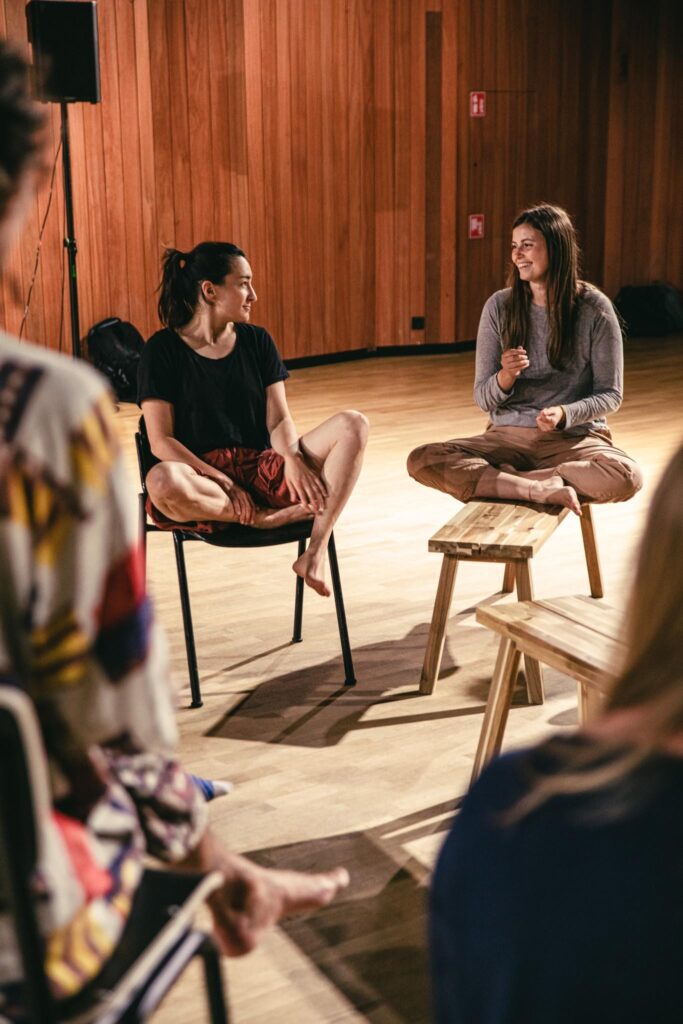The Croatian aerial artist Dora Komenda and the Italian architect Cristina Gallizioli worked together in Ghent from 19 until 30 June 2022. This is their logbook.
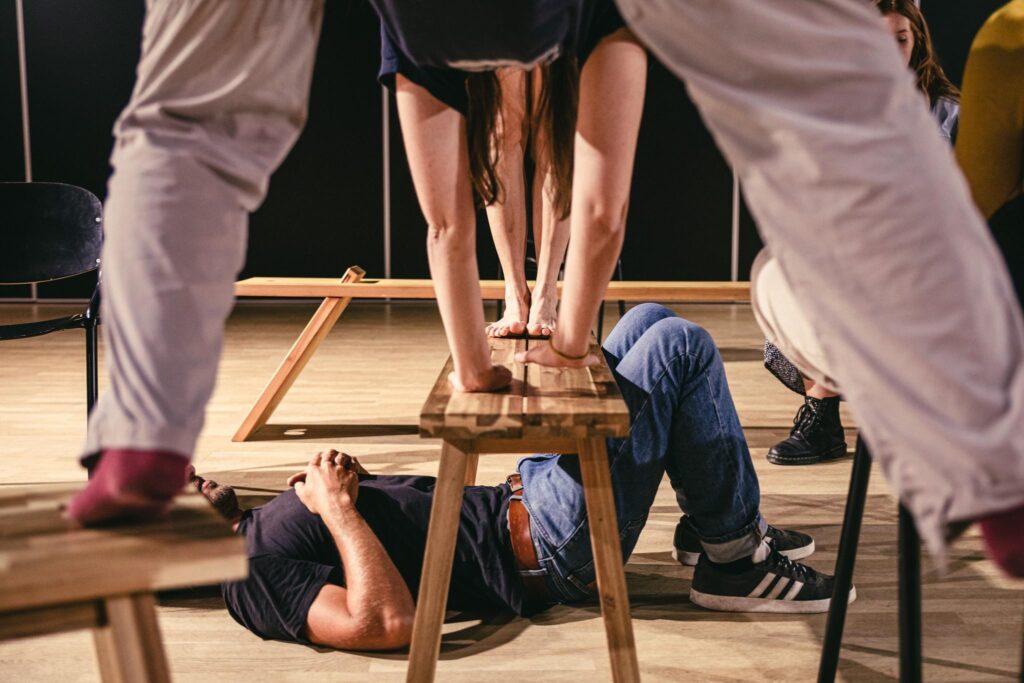
Before the residency
We are happy about the match between the two of us: Dora has two parallel artistic directions, being an aerialist and an architect, and Cristina integrates performance in her architecture artistic practice. During the residency in Ghent we would like to work with architecture (intended in a broad sense as a feeling of space and place) and the bodily experience of the performers and spectators connected to space. In our online meetings before arriving we are also throwing ideas about bodies as spaces, building with bodies, equality of all the bodies that participate in an action and questioning the dynamics of who is looking and who is performing.
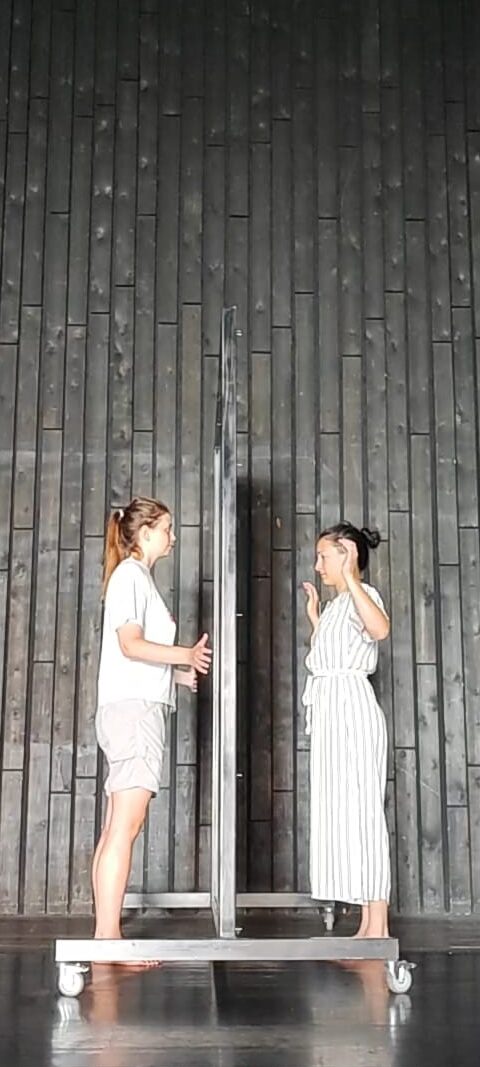
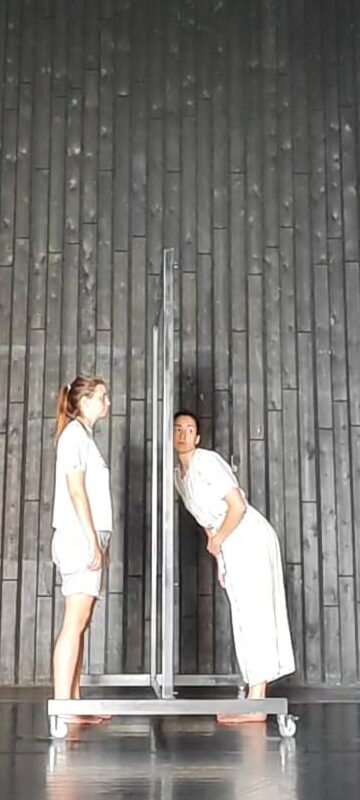
DAY 1
In Ghent we have our 12 days residency at De Expeditie. In the first days we talk about interests and wishes for the residency:
- Cristina would like to perform and use/feel her body more, in this project and in general in the future
- Dora would like to research through a circus discipline, since this was missing from the first match and it felt too far outside of the comfort zone
We have some improvisation sessions to get familiar with each other’s bodies, we rig the fabric and we have a nice experience where Dora moves in the air and Cristina moves on the floor, but we’re trying to maintain eye contact at all times. It works because it makes Dora find new solutions for moving vertically in the air because the goal for movement is changed, and for Cristina it’s also a new discovery, because normally the position of a spectator is fixed in space, through chairs or perceptive markers that define who is on stage and who is off stage. By moving in space with the role of a spectator, Cristina can experience aerials from right below the fabric, lying down with the head facing the show, standing face to face with Dora etc. A different and moving position of the spectator impacted the performance for both.
In this very initial moment, we draft a few questions and goals…
Questions of the day:
- What is our relationship on stage?
- We have two performers where one is using circus skills and the other one is not. Is circus technique inevitably taking over all the attention, especially aerial with such a strong vertical trajectory?
- How can we perform together and make peace with this difference?
- Do we each stay in our own medium or do we skip circus and do things that we can both do equally?
Conclusions and goals:
- Achieve equality between audience space and performance space
- Change the perception of the performance by changing the position of audience in space
- Movement of the performer corresponds directly to the changed (or continually changing) gaze of the observer
- We shouldn’t invade somebody’s space, but invite them to “our” space


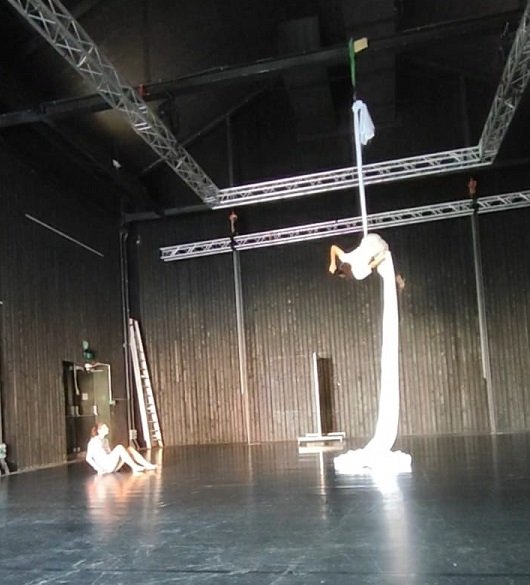
DAYS 2-5
The following day we expand these first intuitions into the direction that we want to create a sensory experience of the performance for the audience.
The way to this? We have an idea to design a scenography for the audience, in contrast to typical scenography design that is always intended for the stage and the performer, not for the people in the public.
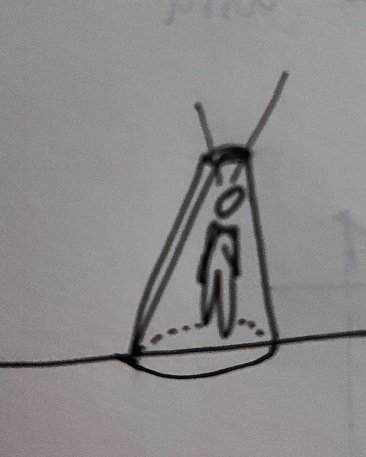
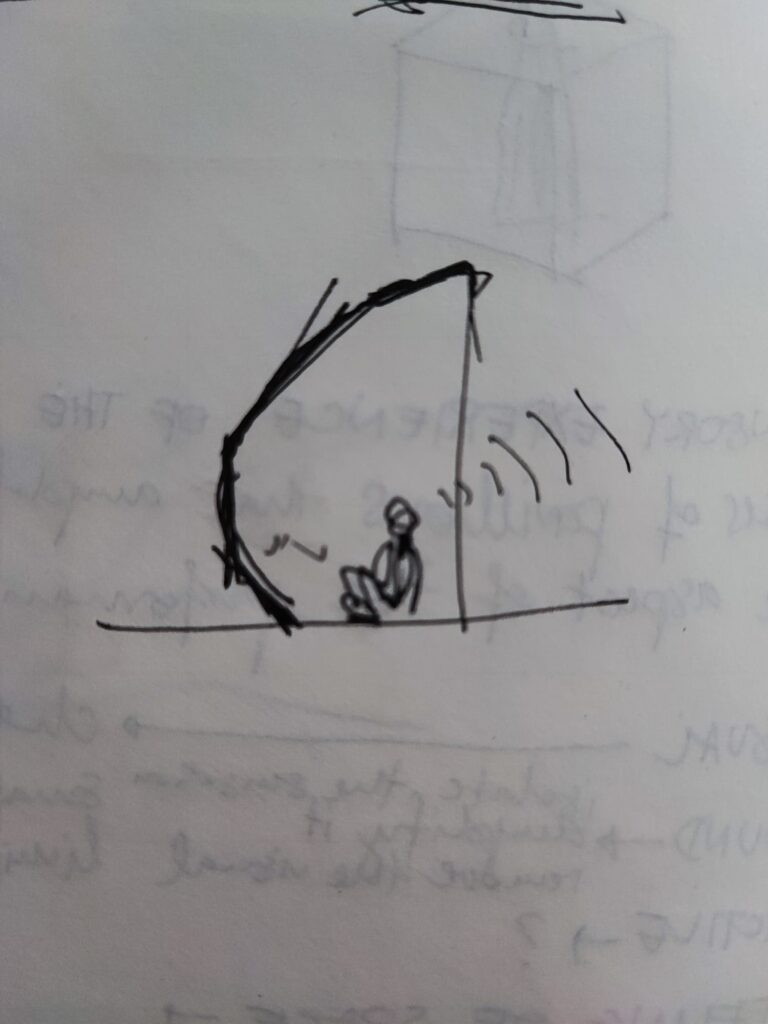
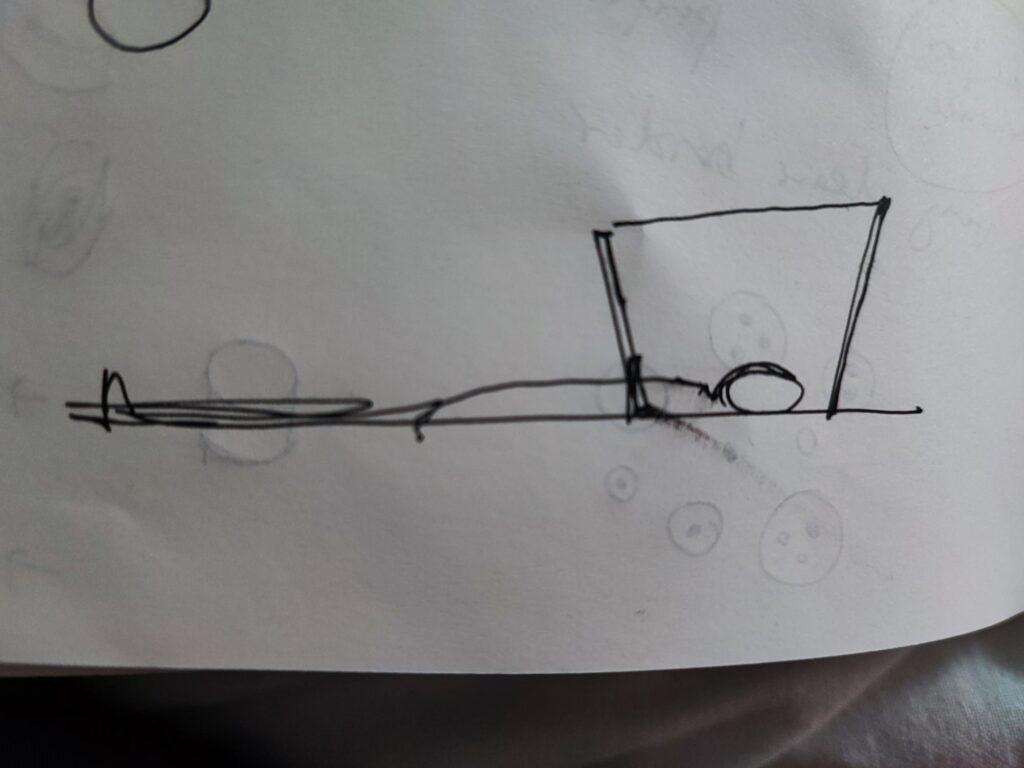
We start talking about different senses the audience can use to experience the performance besides just watching and listening from one spot. Before making interventions in the design or the performance, we start paying attention to what’s already happening:
– sound of the fabric, sounds of performing (breathing, etc…)
– vibration of surfaces that bear force of movement
– tactile experience where the public is in contact with the fabric or the performer
– The feeling of space
– The sense of presence
There is immediately a lot of sketching ideas of how to amplify these sensations with different architectural pavilions: each pavilion can amplify one sense on stage. Each person can enter the pavilion and experience the performance through focus on one sense at the time, which will be amplified by the design of the pavilion and of the performance. Each pavilion is intended for one or a few people to use at a time, so that each person has a very individual, one-to-one experience.
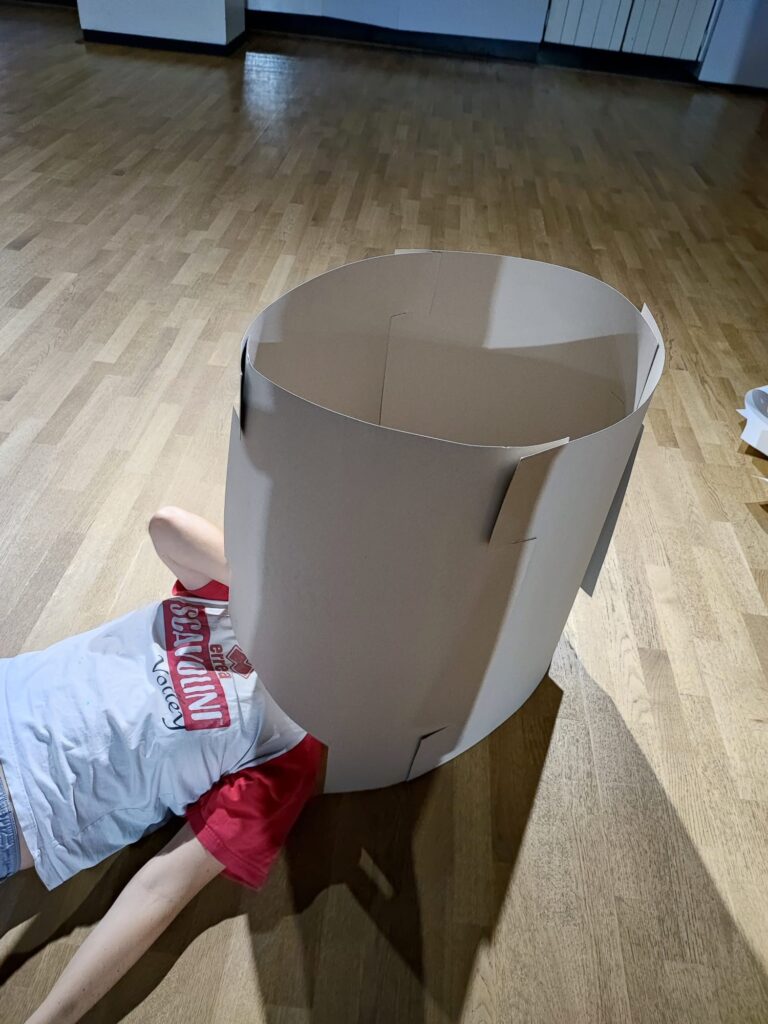
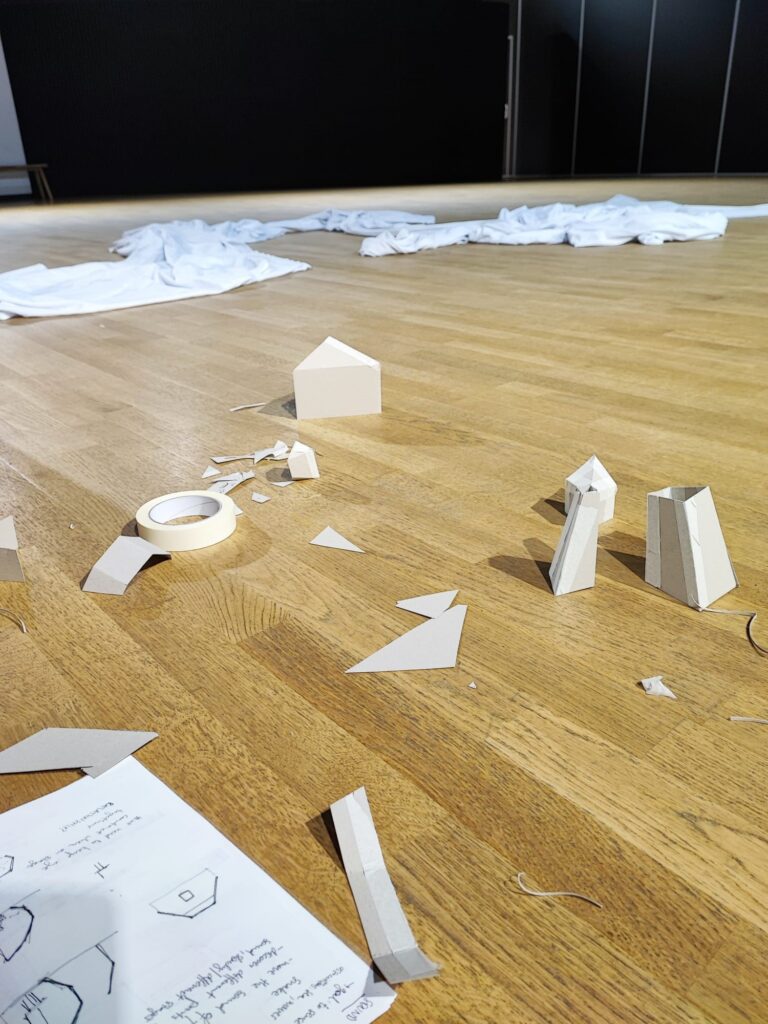
Besides sketching and developing ideas for designs, we explore the performance aspect. How can a design of a prop influence the performance? We realize we need to create a specific performance for every sense and every design.
We always perform for each other, one is always the spectator. The experience of the spectator is important – it’s the base for research, so the one observing is really focused on the senses. We draw many interesting observations with this method, from both perspectives – performer and audience.
We make different paper models, as a way of 3d sketching and developing spatial ideas. We enjoy the method a lot, it’s how we both usually do things in our design practices so we correspond to each other this way.
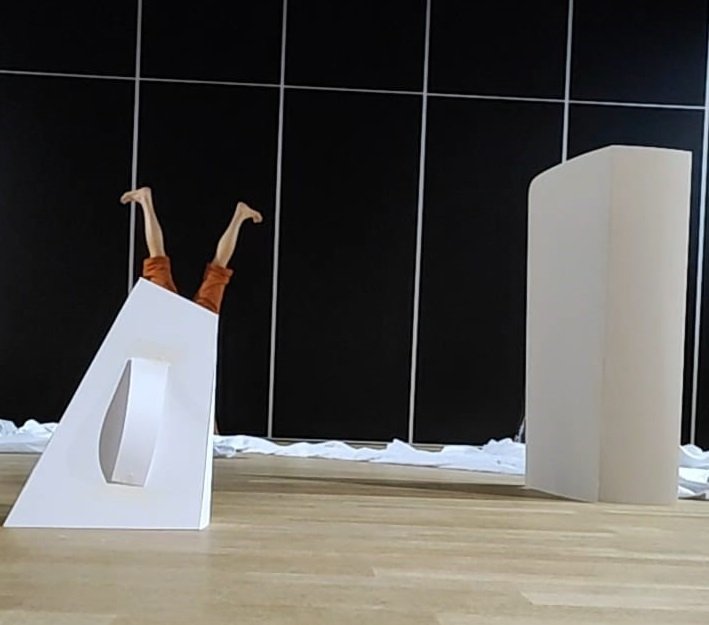
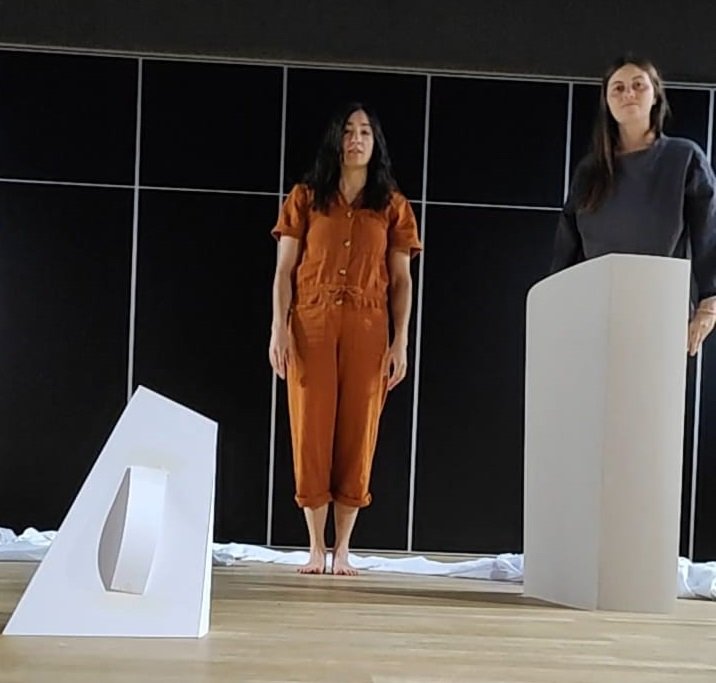
Questions of the day:
- did we just put limits on the experience by making the audience focus on only one aspect? Our feeling says that the ones just observing in a “normal” way have the most boring experience out of everyone else.
We make a conclusion that we can have two different approaches. A free format, where the audience should be able to move whenever they want and explore the sensory pavilion landscape however they want. Or a precisely designed pathway where we dictate the order of things, since performances are created for every single pavilion separately. At the end of the day, it all starts to sound a little bit overwhelming and complicated.
BUT!!!
On DAY 3 there is a misunderstanding with the work space, we are moving to another space with no rigging – so no aerials. Dora has no infrastructure to do her discipline, but it’s quite important for her and to continue the work we started. It’s quite demotivating but there will probably be no more aerial techniques used in this collaboration. Dora is asking herself – am I able to work if I don’t have a circus discipline involved? What can I give to this collaboration if I don’t have the possibility to work in my medium? It was supposed to be a collaboration between a circus artist and an architect, not between two architects.
We move to another space with no rigging, we focus on the floor and deal with Dora’s circus equipment in a different role. It’s 20 meters of fabric, this time not suspended in the air, so: unfamiliar territory, new input, many questions.
- Do we need circus equipment in these new circumstances? Can we find ways to use it? Why do we even want to include it?
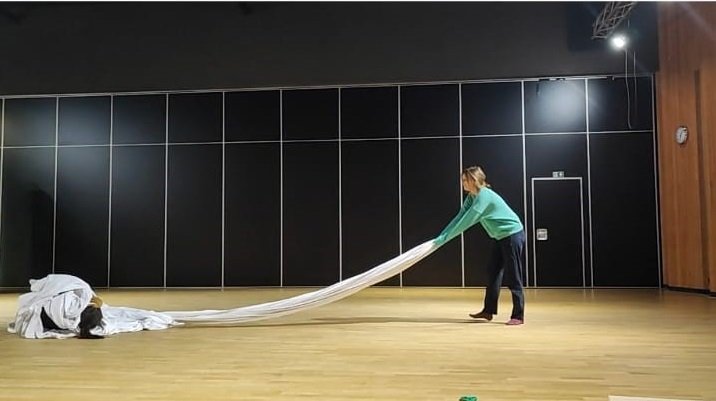
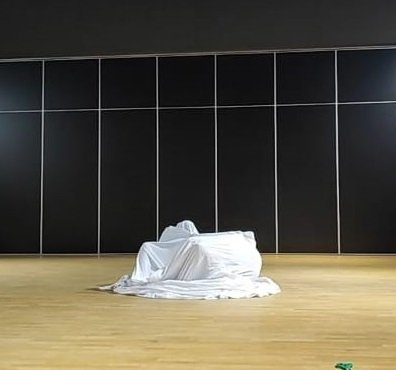
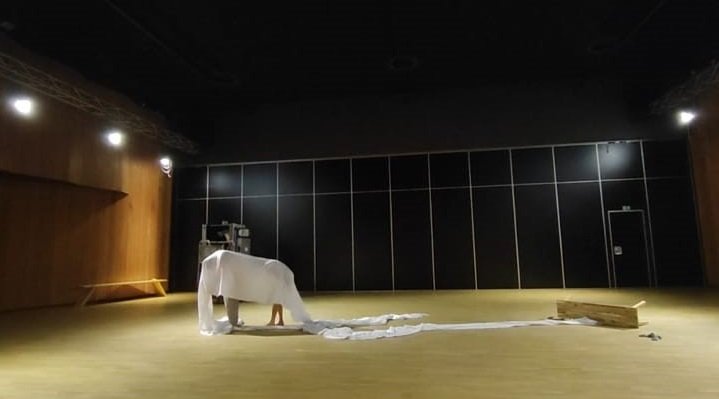
DAY 6
Next day we have an hour with Alexander Vantournhout. We present our struggles and conclusion that we don’t need 7 meters of height and a rigging point to do aerial technique, we don’t even need the circus equipment, it’s just about finding the principle of being suspended in the air in other ways. The technique is the same if the feet are 2 cm or 782 cm from the floor.
We come up with a simple exercise on an outdoor playground we can both do with slings and show him the concept. Understanding the need to remove the burden of dependence on circus equipment, Alex pushes our idea further and we use the same exercise but this time without any extra objects, just improvised movement in the existing playground, however we want to express. We both discover our own ways to move around it. In this moment, we bridge the skills/no skills gap between us and all three of us take turns, improvising for the other two with the first goal of the first day: playing with closeness and placing the spectator in unusual positions to observe, for example right below the performer or face to face, carefully testing the level of what is comfortable for a performer and observer equally.
We can remove unnecessary elements from our work, no need for the rigging, or for architecture pavilions – just focus on the position of the audience on stage and free movement and equality of the participants.
DAY 7
The next day we create our own landscape made out of chairs and benches. It is the space for performers and audience equally.
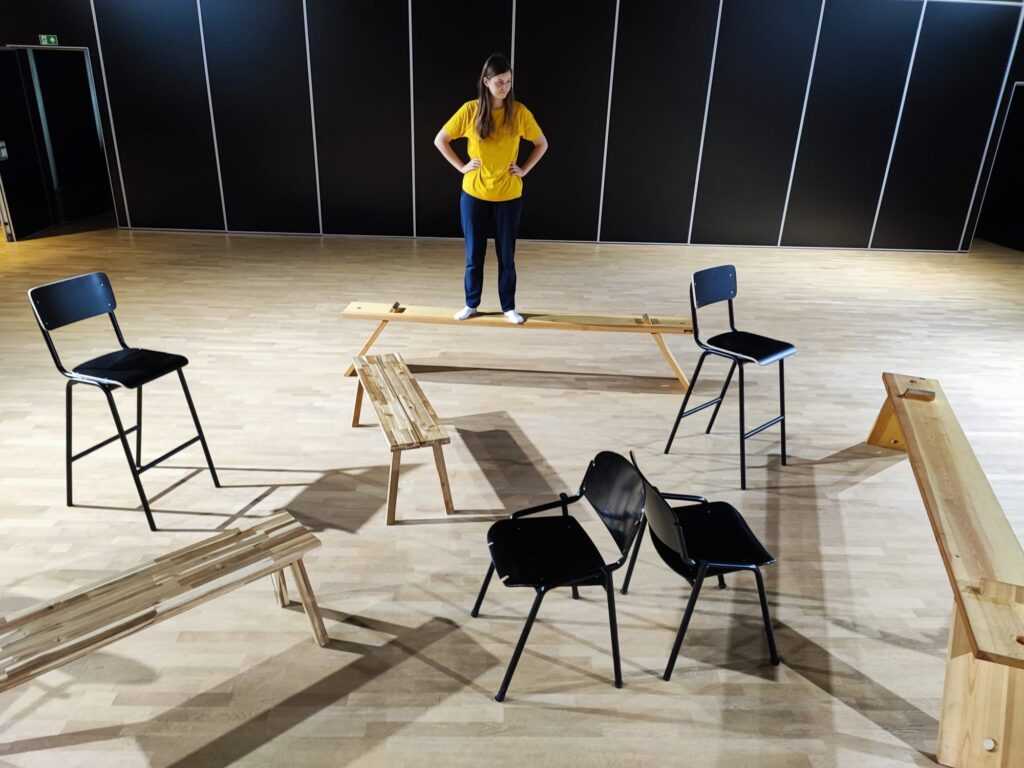
We position the chairs in space with awareness of the borders, proportion and the exchange between volumes and emptiness, just like with any other architectural design. We finally find joy in moving, exploring and performing for each other. Cristina is happy to navigate the landscape made of chairs and discover what she can do with her body and Dora doesn’t feel deprived of circus or physical expression. Our mentor Marieke De Munck visits us in the afternoon, and we already have a concept for the performance, the audience trajectories and rules for them to participate in the show. We’d like to develop a performance where the audience space is the same as the performance space. The audience is invited into a landscape made of chairs and benches.
DAYS 8-12
The idea unfolds further very fast and we are able to build a general structure of the show in a couple days we have left. We’re developing a show in which the audience is invited into a landscape made of chairs and benches, in which they can decide how to position themselves or move according to a few simple rules. The audience space is the same as the performance space, one shared environment.
In the beginning, as a suggestion we show some possible positions to place themselves in the landscape and enjoy the show from different perspectives: lying on the floor, on a bench or under a chair, standing on a stool, etc. During the show, whenever they want, the spectators can move to change their position and observation height, as well as their closeness to other spectators and performers. We perform into this ensemble of furniture and people, giving attention to each person participating and navigating space with our way of movement.
When the public takes the first position in space we start performing, but during the show the role of the performers and the observers blurs and exchanges, depending on the group dynamics and the type of positioning and moving choices each person makes, until eventually there could no longer be any difference between the performers and the observers. We all share the same power of deciding what happens next in the experience and hold freedom of movement and play.
We’re discovering so many little details to develop for this project and the exchange with our mentor is very rewarding. Marieke brings our attention to some important points: how to invite people to participate, how to communicate the rules, how to relate to each person during the show, and how many people we should include. We’re trying with bigger and smaller landscapes, more and less people inside.
To communicate the rules, we decide to have a recorded voice giving instructions while we’re showing examples of positioning possibilities, all for the purpose of presenting an open choice the participants can make – not limited to our examples but taking them as a suggestion.
We have some tryouts where we observe different responses and levels of participation in the game and draw many conclusions from the tryouts.
PRESENTATION DAY
On the last day we have a final presentation for a small audience. Even though we both never worked with participation concepts, and Cristina never performed in a movement setting, it works. The audience responds to our propositions. We feel like we created a feeling of togetherness. The talk afterwards is rewarding and full of important reflections. We would like to develop this project further beyond the CWC project, and keep contact with our mentor Marieke. We even give a name to this project – Take a place!
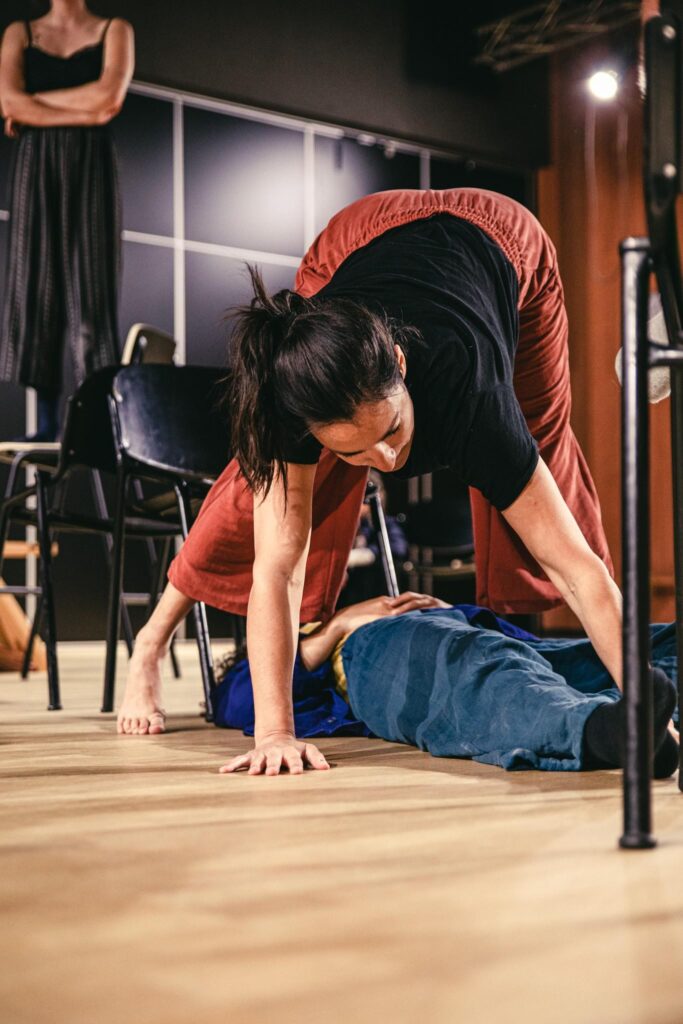
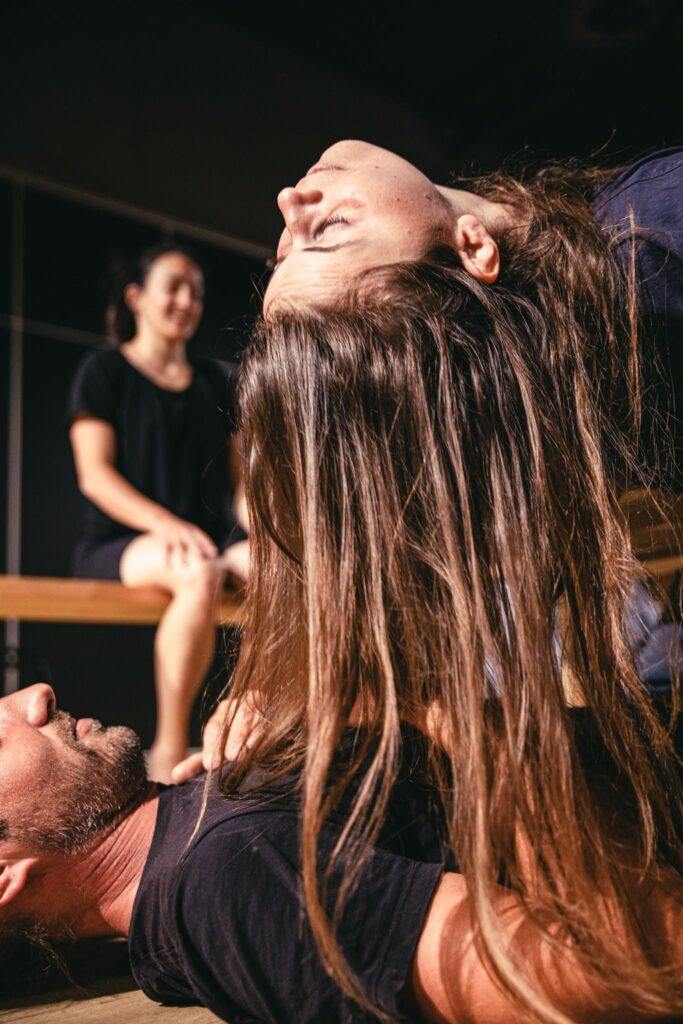
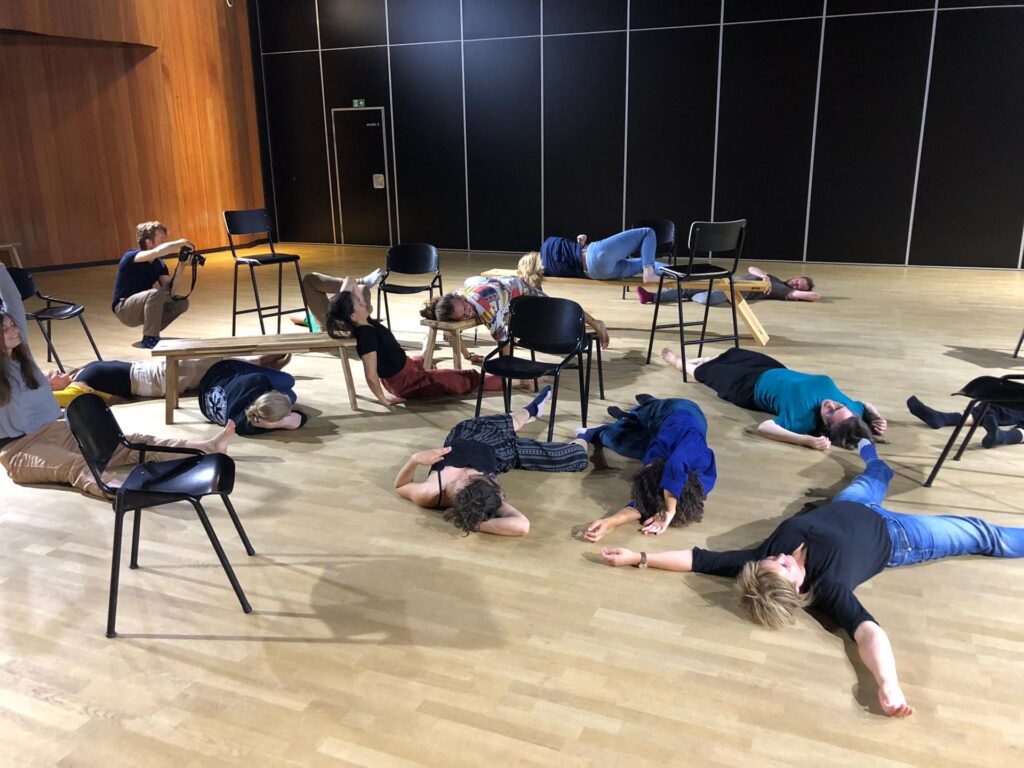
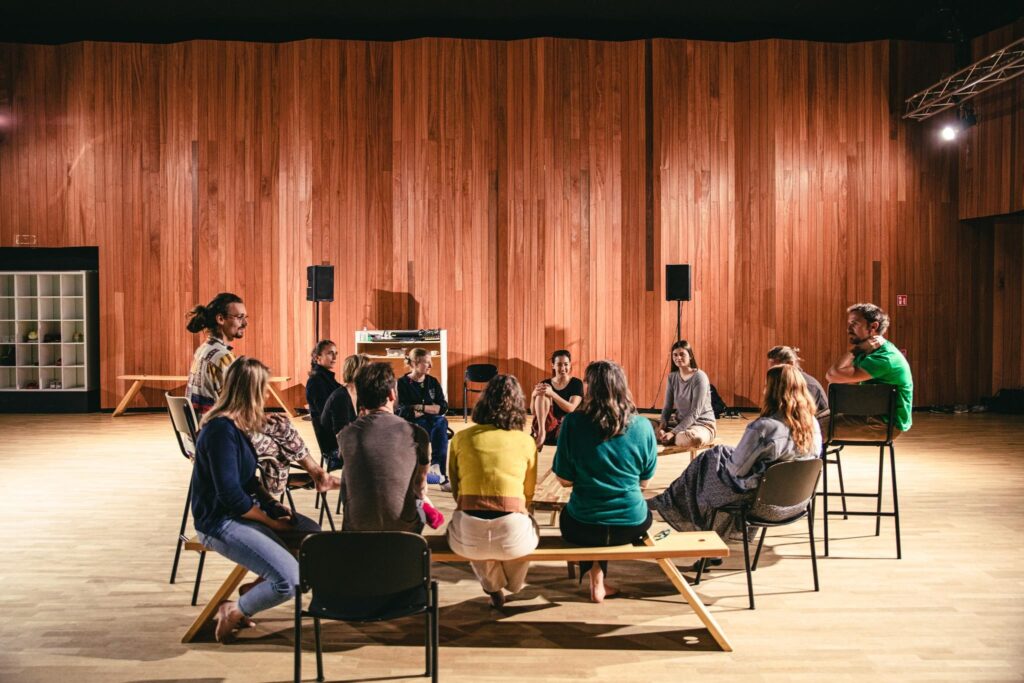
Afterthoughts… for the future!
INTERDISCIPLINARITY AND FORM
- Dora: I learned that interdisciplinarity can be found in the approach, in the process, and/or in the product, but not necessary in all of them. The two disciplines together can intertwine more or less intensely. In my previous interdisciplinary experiences I realized my partners and I were approaching everyone from their medium, and the magic would happen in small touching points. In this work, I feel like we intertwined a lot more, but the result is not architecture, and arguably not even circus. If there is a handstand in the show, does that make it a circus show? I don’t really think so, and I also don’t think it’s a relevant topic for this particular work.
- Cristina: In the last few years I’ve been struggling to communicate that what I do is still architecture even if it doesn’t look like it. I think the final show was architecture, in the sense of creating spatial relationships between matters and densities, an architecture made by bodies in movement. I wonder if I can create a sense of risk for myself while climbing within my limited movement plasticity, or risk for spectators with the perspective and proximity, to change the intensities during the show and make it more circus for me, with my skills.
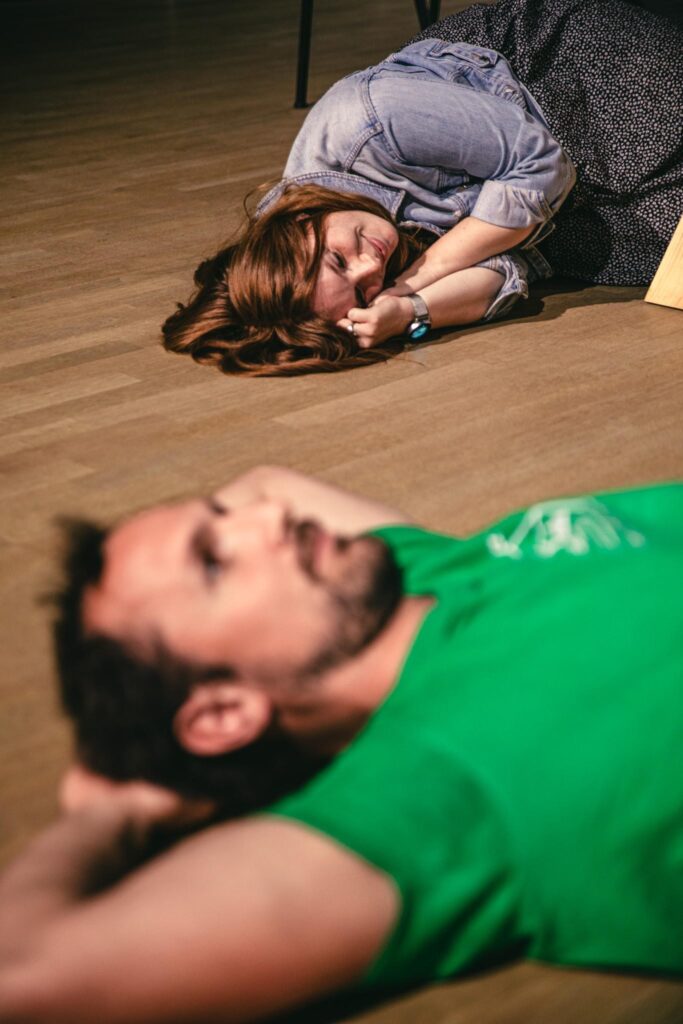

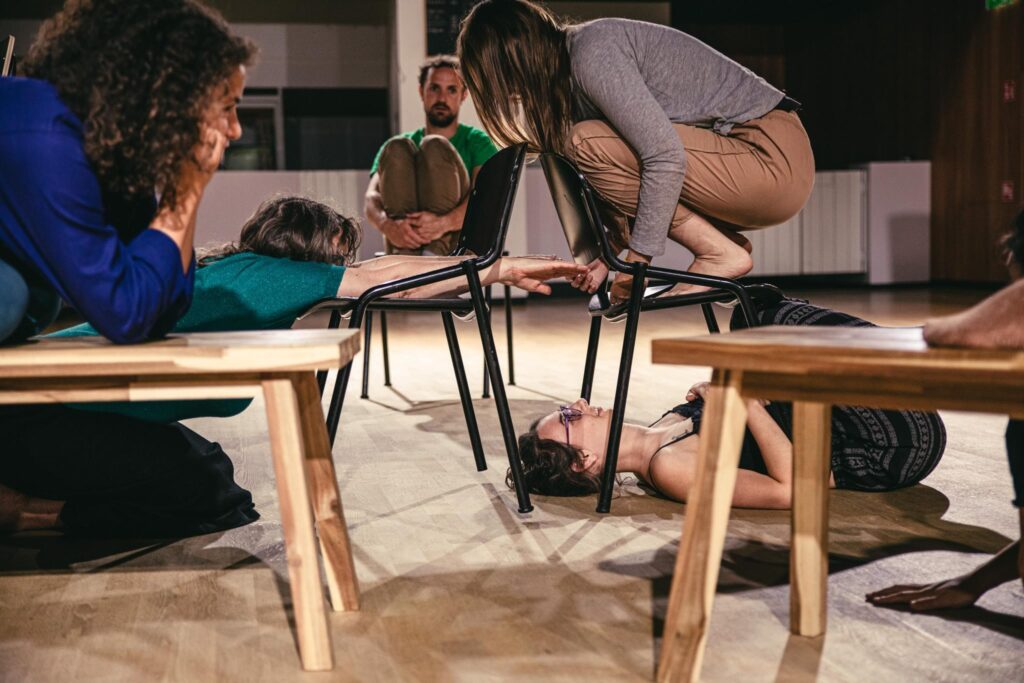
ARCHITECTURE, CIRCUS, OR NONE OF THE ABOVE
- Dora: It’s important to brand things in the right way, so the approach was definitely from circus and architecture, but the end product equally is and isn’t circus as much as it is and isn’t architecture. We can call it just ‘performance art’ and everyone is happy. I think it’s circus without (obvious) circus and architecture without (obvious) architecture.
- Cristina: yes, but on the other hand it’s important to expand fields. Why is architecture just buildings? What is circus at its discipline borders? Maybe this work IS circus and IS architecture. Because it’s created by us with an architecture and circus thinking and research.
PARTICIPATION AND INTERACTION
- Cristina: I had a very strong experience for myself while performing in this landscape. I’d like the public to experience what I feel, to share my perspective and be inspired by their perspective, I’d like to bring them to feel the energy of space and people. Don’t force into action and participation, but suggest a pace and perspective, which can be bent, taken, or not.
- Dora: The experience and knowledge I gained from my first residency with Ilon, who is a participatory performance artist, influenced what we did here a lot. I feel like for me the project is fulfilling its purpose because I would never (or very unlikely) be exposed to some different artistic approaches that I experienced in the frame of CWC.
STAGE SPACE = AUDIENCE SPACE / TOGETHER ON STAGE
- Cristina: even though I was performing I didn’t feel watched/observed, I perceived myself as one of the many characters on stage. This gave me freedom to stay in “my” journey, and accidentally cross other people’s journeys.
- Dora: It’s exciting to create a frame for somebody and let them have the freedom of their own decisions. Not controlling the outcome is a nice new sensation for me.
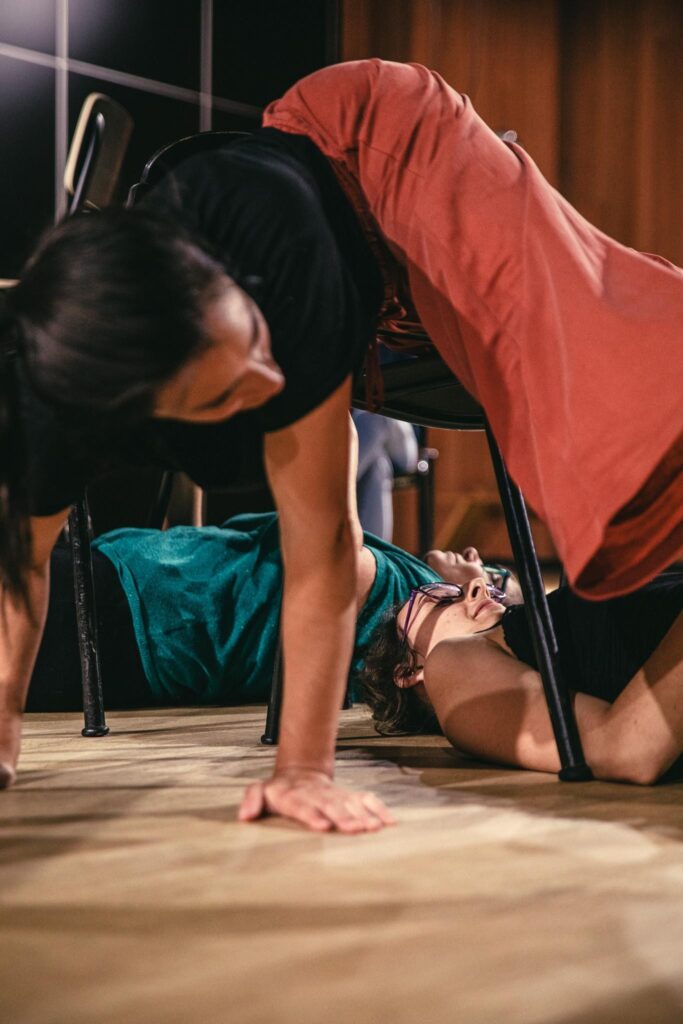

RELATIONSHIP TO THE INDIVIDUAL
- Cristina: The public is not a flock but each person brings into the show a value and individuality. We ask for a positioning of each person, with a certain freedom in choice, this reflects their character and unity and we can relate with this while performing: how close, how far? How fast? Contact? Eye contact? How do you move? From where would you like to watch? And be watched? Center or periphery? From above or from below?
- Dora: it’s interesting to come so close and to be so aware of the people, so much that we build our next decision in the performance based only on their decisions and behaviours. It’s a new experience for me and creating this I felt like my comfort zone is expanding.
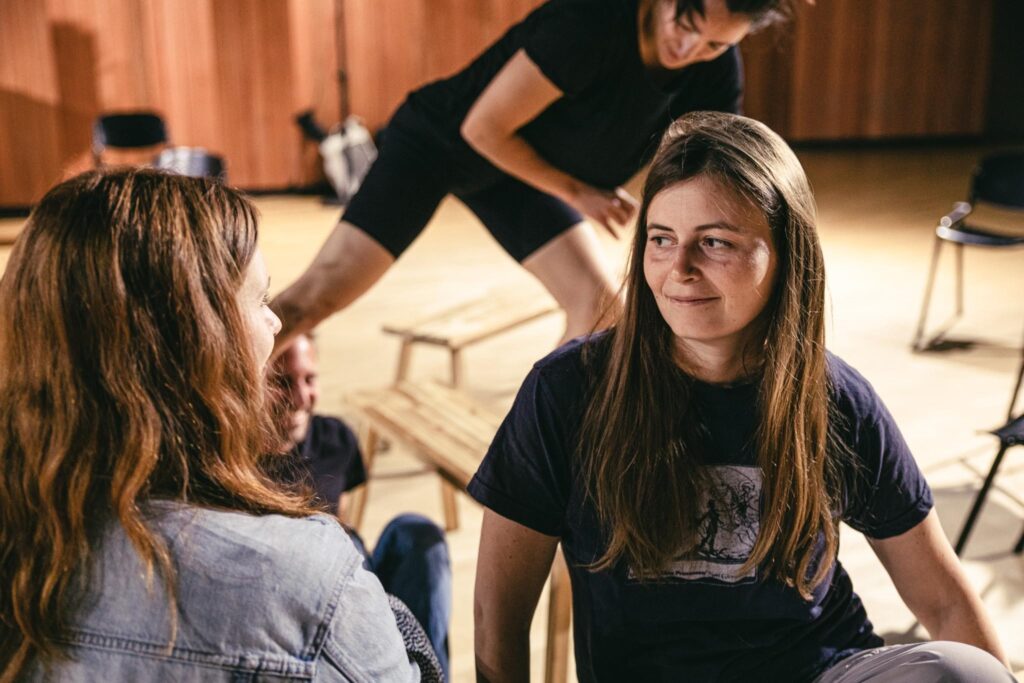
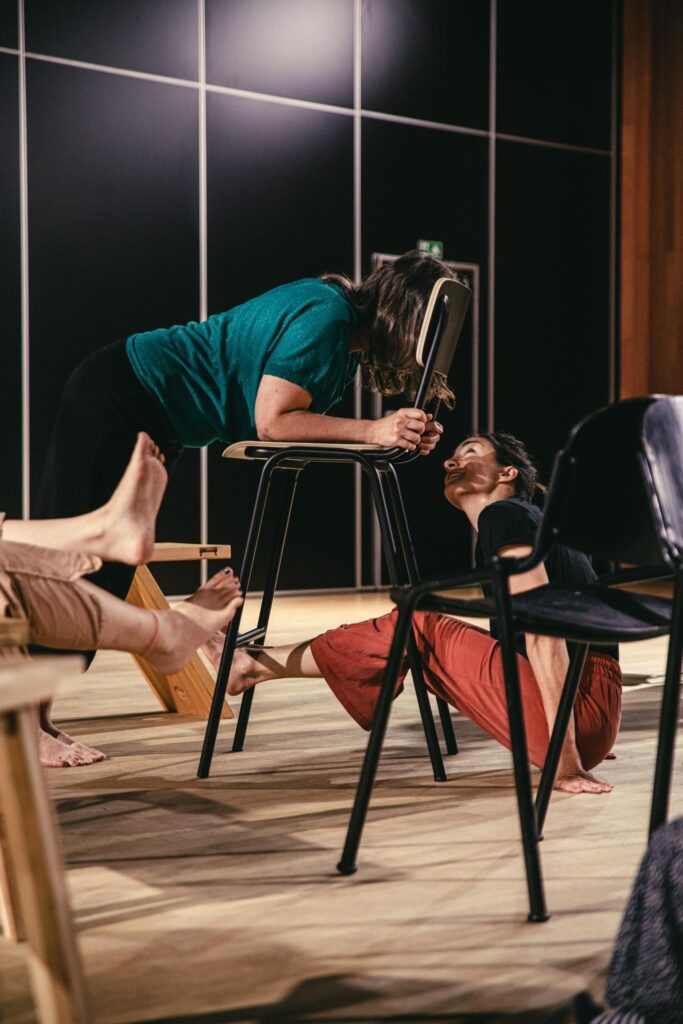
LANDSCAPE OF PEOPLE AND OBJECTS
- Cristina: Open topic: are people and objects equal? Can we equally relate to a bench and to a person and what does it mean? Extend unicity and personality to objects onstage, build a relationship based on holding our weight, oscillation, my materiality and benches materiality in contact. How do I touch the skin of the bench? How do I listen to a chair cracking? My knees crack too. Distribute attention to all participants, benches included. Thank the benches and floor for holding us and creating the structure for us to move. Respect their materiality: what happens if I break them? How do I switch from using them to being together with them? Does a bench hurt me? Where do I find bruises on my body due to hard contact points?
- Dora: I am interested in Cristina’s perspective of giving more importance to furniture, but I don’t relate to treating furniture and people with equal care. Encountering a chair in my movement pathway can never be the same as encountering a person with thoughts and feelings.
GIVING RULES
- Cristina: way of communicating should be adapted by the context and audience. Try some presentations in different places and audiences and test different introductions: by voice, by drawing… rules should feel open and give a frame for freedom
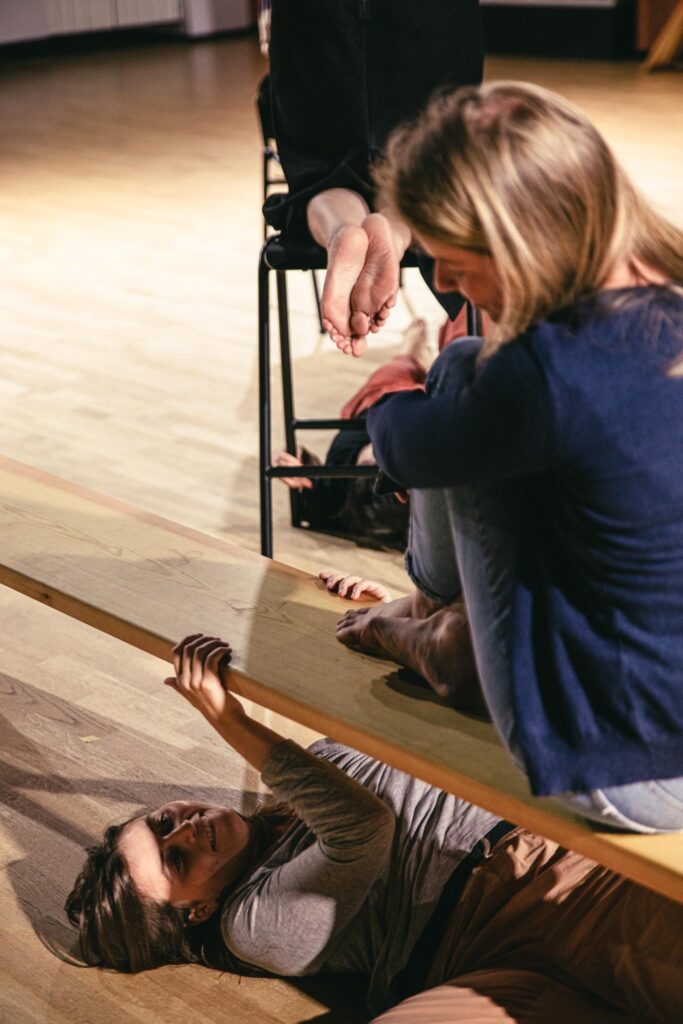
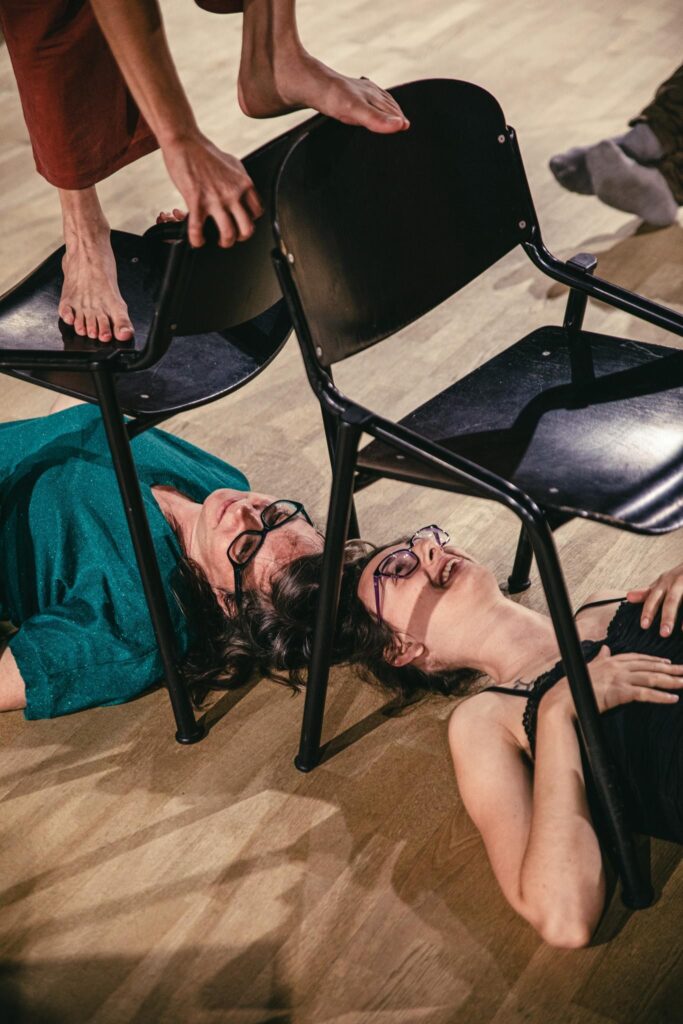
PUBLIC SPACE
- Dora: Testing the structure in public space brought new elements and changed the performance. Shadows on the floor, random little objects in the way, interaction with passers by. It’s something to be explored more. What can it give to the project and how does it change the results. How much or how little control is necessary for the thing to still work.
TYPE OF OBJECTS
- Cristina: If developed into a show, instead of benches, can we design the objects for the scenography (like in our first residency ideas)? How would they look like? Or what if we take the structure of the city instead? Railings, steps, public benches…
- Dora: I feel confident with the simplicity and practicality of ready-made objects you can find anywhere. I love that by arranging them in space we create a playground, something that is not just a bunch of chairs in a room, but a composition created with a purpose and rules in mind. For me this is architecture. It would be interesting to try to design objects that create this landscape, probably based on typology of movement we want to have, but right now I’m seduced by simplicity and universality of just using chairs and benches. I also think they relate much more to the audience because they are common and familiar, and you already have the knowledge of how to use them.
